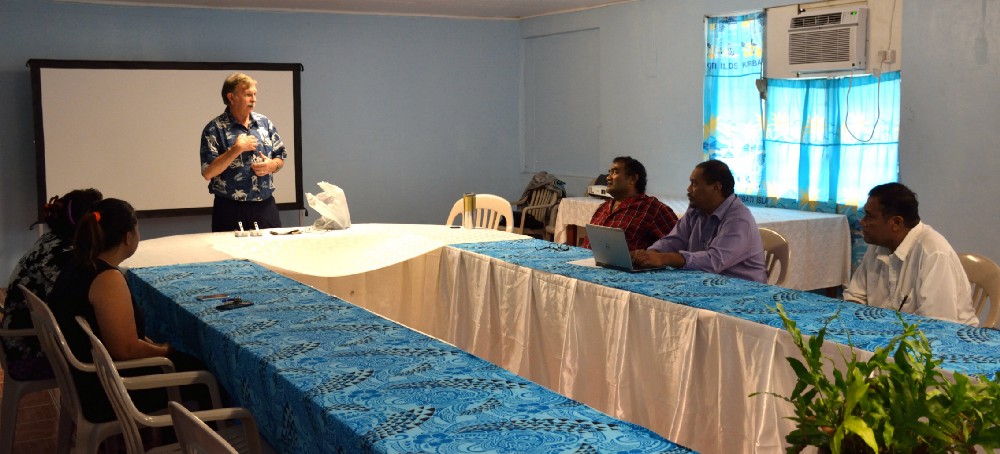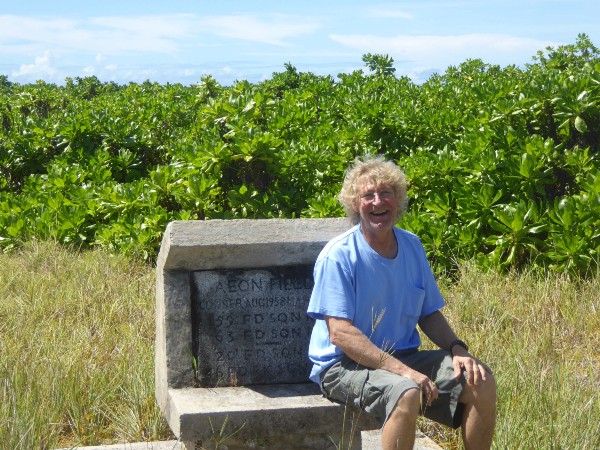Super Bowl “Sunday” in KiritimatiFebruary 8, 2016by Paul Johnston (CIRES)
 From left to right: Jackie, one of the KMS staff; Kata, KMS OIC; standing is yours truly, Paul; Kabure Temariti, our host and CEO of the Captain Cook Hotel; Bewereti Tewareka, OIC of Kiritimati for the Ministry of Line and Phoenix Islands Development, one of the top civil servants on the island; Toroto, one of the main hotel staff who is in charge of air conditioners among other things, making him very important to the project staff’s comfort. (Credit: Scott Abbott, NOAA)
From left to right: Jackie, one of the KMS staff; Kata, KMS OIC; standing is yours truly, Paul; Kabure Temariti, our host and CEO of the Captain Cook Hotel; Bewereti Tewareka, OIC of Kiritimati for the Ministry of Line and Phoenix Islands Development, one of the top civil servants on the island; Toroto, one of the main hotel staff who is in charge of air conditioners among other things, making him very important to the project staff’s comfort. (Credit: Scott Abbott, NOAA)
Super Bowl “Sunday” in Kiritimati
February 8, 2016by Paul Johnston (CIRES)
KIRITIMATI ISLAND, Kiribati — Yes folks, while Colorado was preparing for the Super Bowl, it was Monday here in Kiritimati (pronounced ‘Christmas’). Today was a big day for us — we held an official opening ceremony for the NOAA El Niño Rapid Response (ENRR) Kiritimati operations. With the help of Ms. Katanute “Kata” Tuevi, Officer In Charge (OIC) of the local Kiribati Meteorological Service (KMS), we formally invited the top officials from Kiritimati, the local KMS staff, and a couple other people who are key to our project. Unfortunately, several of the invitations were to people who are in Tarawa, the capital city of Kiritibati (pronounced ‘Kiribas’), for the meeting of Parliament.
The reception was supposed to start at 10:00am LINT (Line Islands Time), but it was raining and things move a little slower here — a concept known as “island time”. Finally at about 11:00am, the meeting started. We discussed the ENRR project that has brought us to Kiritimati, stressing how important the Kiribati government had been in approving this project. We also thanked the KMS staff, as well as the Captain Cook Hotel (CCH) staff for their assistance.
It was a small group, but all were attentive and asked lots of questions — including obvious ones about El Niño and climate change. All of Kiribati is sensitive to climate change, since most of the country is on coral atolls that are very close to sea level. As is common when people learn we are working with weather, they want to know tomorrow’s weather. My answer is always that I make measurements of weather, and don’t make forecasts. I tried my best to answer the questions I knew the answers to, and pleaded ignorance when necessary. After about an hour of discussion, we adjourned and went to a group lunch prepared by the hotel. Kata’s daughter, Lisa, joined us for lunch since school had been cancelled due to heavy rain over the weekend.
After lunch, we went to the radiosonde launch site, where Scott and I prepared our normal 1:00pm launch. The photo below at left shows the answer to one reader’s question: “Where do we fill the balloon?” The red door on the left is my room, with the radiosonde ground station. The door on the right is Scott’s room. In the area in front of his door, there is room to fill the balloon inside the blue tube, even when it is raining. We then move the balloon out to the grass for launch. The black strip on the tube is Velcro, used to release the balloon after the radiosonde is attached.
 PHOTO LEFT: From left to right are Toroto (in his new NOAA cap), Kirario Totie, chief of operations for the CCH, Bewereti, Lisa, Kata, and Scott. (Credit: Paul Johnston, CIRES) PHOTO RIGHT: Bewereti launches the radiosonde with Paul’s guidance. (Credit: Scott Abbott, NOAA)
PHOTO LEFT: From left to right are Toroto (in his new NOAA cap), Kirario Totie, chief of operations for the CCH, Bewereti, Lisa, Kata, and Scott. (Credit: Paul Johnston, CIRES) PHOTO RIGHT: Bewereti launches the radiosonde with Paul’s guidance. (Credit: Scott Abbott, NOAA)
It was a nice day for a launch. Just after 1:15pm, our earliest launch time, Bewereti released the radiosonde, with directions from me. It went 25.4 km above the ground, providing good data for our research.
 Scott gets a “play-by-play” on the Super Bowl. (Credit: Paul Johnston, CIRES)
Scott gets a “play-by-play” on the Super Bowl. (Credit: Paul Johnston, CIRES)
The actual launch time was 1:17pm Monday, February 8 in Kiritimati, and most importantly for Broncos fans, it was 4:17pm on Sunday, February 7, in Boulder. While I monitored the radiosonde, Scott went to the WiFi hotspot in the CCH lobby and called his wife, Sue, in Colorado using Zoom and got a play-by-play report of the Super Bowl from her. This is how we ‘watched’ the game. I joined Scott after completing the sounding and sending in the data to Boulder. Since we had a very serious morning, our Super Bowl party was very relaxing.
 Scott as a tourist visiting Aeon Field. (Credit: Paul Johnston, CIRES)
Scott as a tourist visiting Aeon Field. (Credit: Paul Johnston, CIRES)
The next day was very sunny and nice. It was Scott’s last full day on the island, so we did some exploring on Kiritimati. We went to Aeon Field, a paved runway near the southeast end of the island and about 25 km from the CCH. It was used during the atmospheric nuclear bomb testing done by Britain and the United States before the Comprehensive Test Ban Treaty became effective. Plants are starting to grow through the runway, but it could probably be made serviceable without much effort.
Finally, here’s a video that shows our location — close to the beach, with the constant roar of the ocean. In my room, it sounds like we’re living near an airport with jets taking off all the time. On this day, the ocean was a more active than normal. Usually, there are no breaking waves in the distance, such those just below the horizon, about 1:28 in. For those interested in the weather, the time stamp on the movie is 12 February, 2:55am, UTC, looking to the north. At the end of the clip, the entire operation is visible, showing where we live and work.
